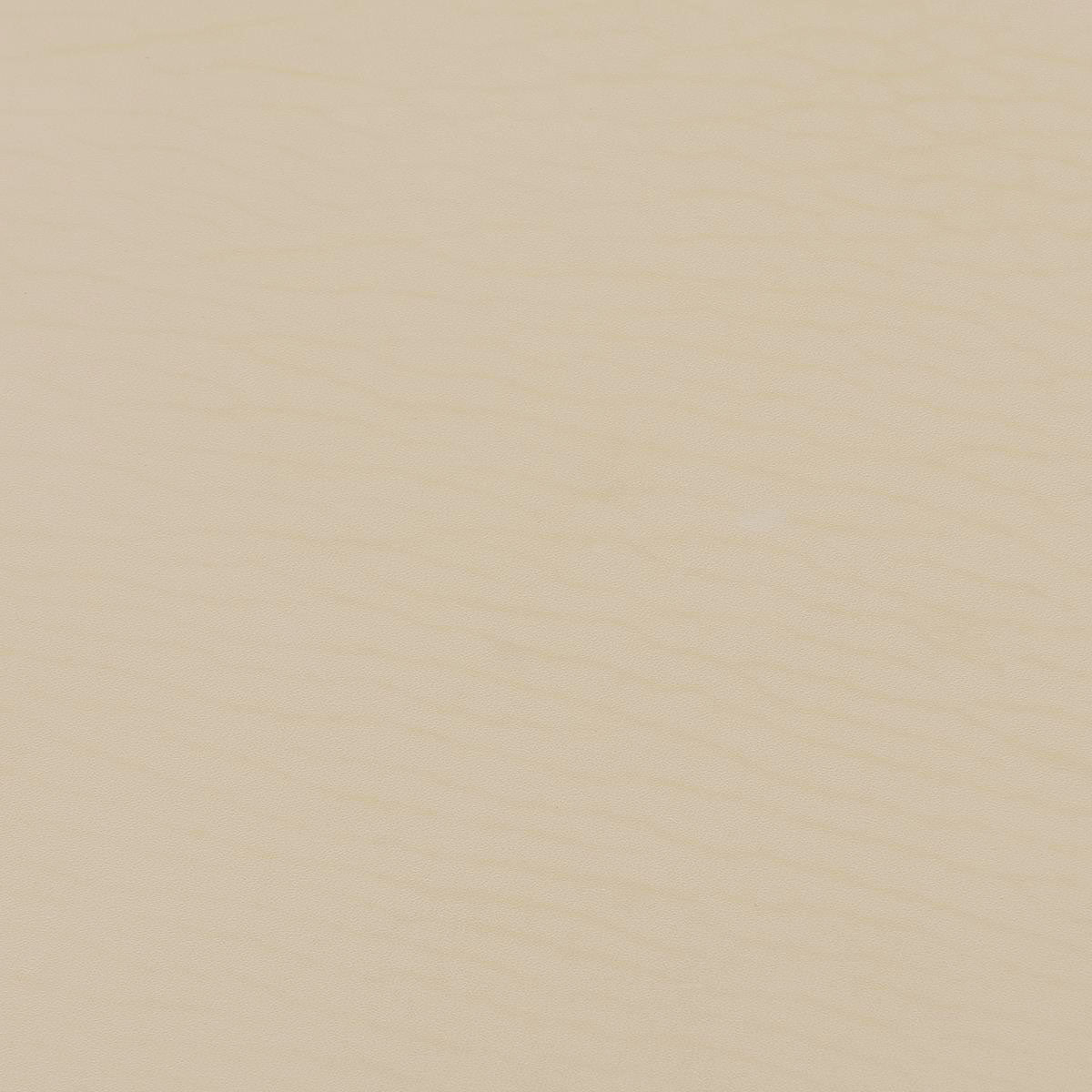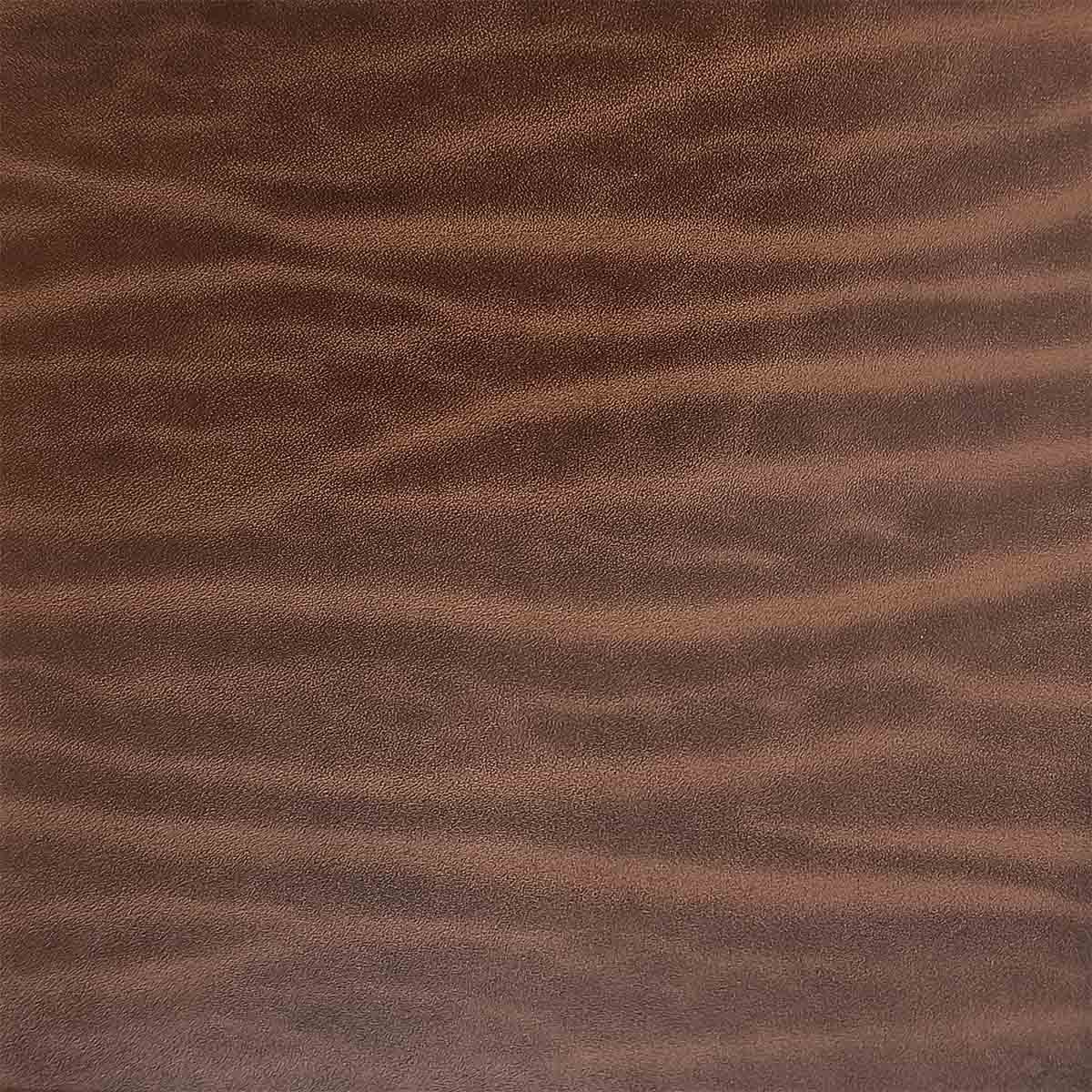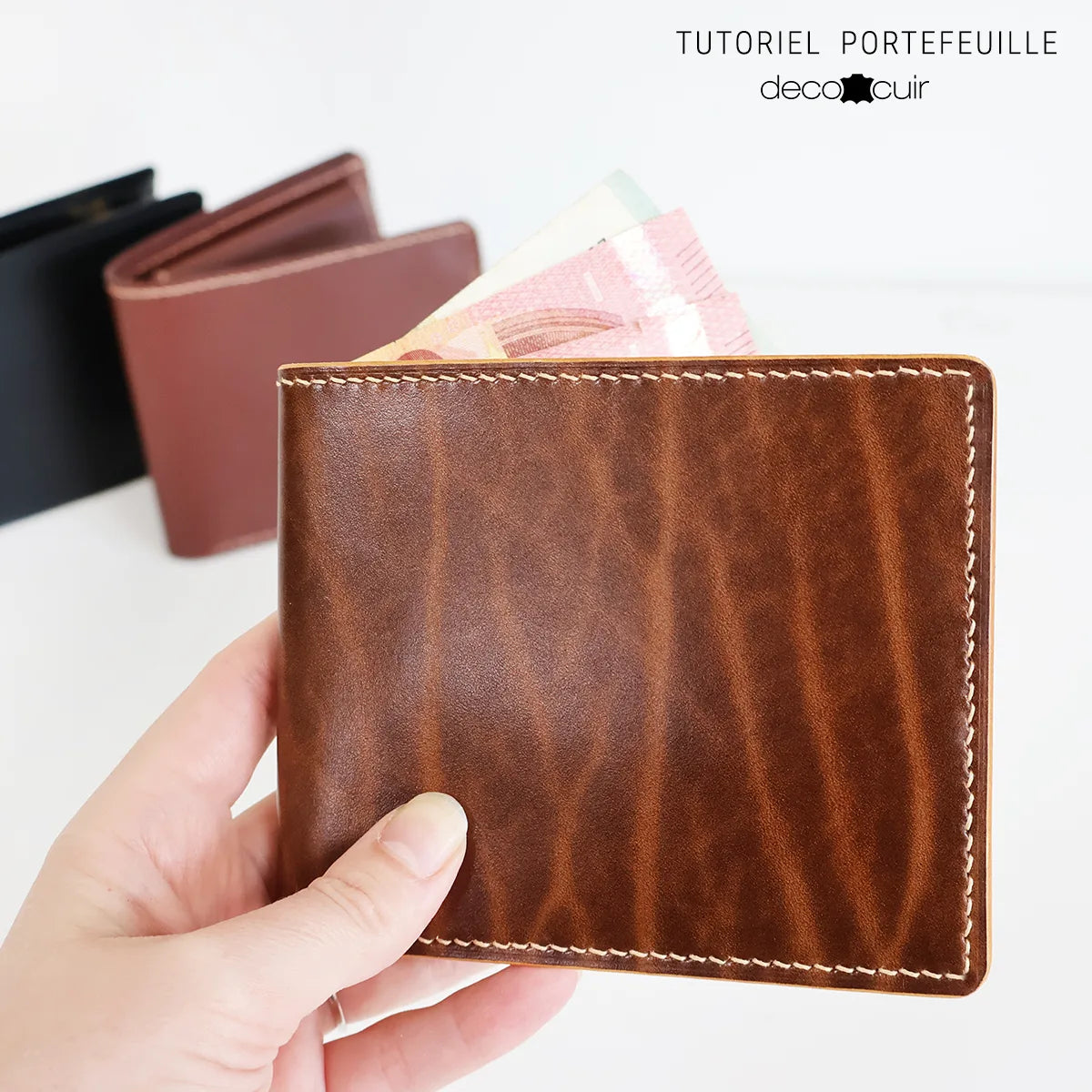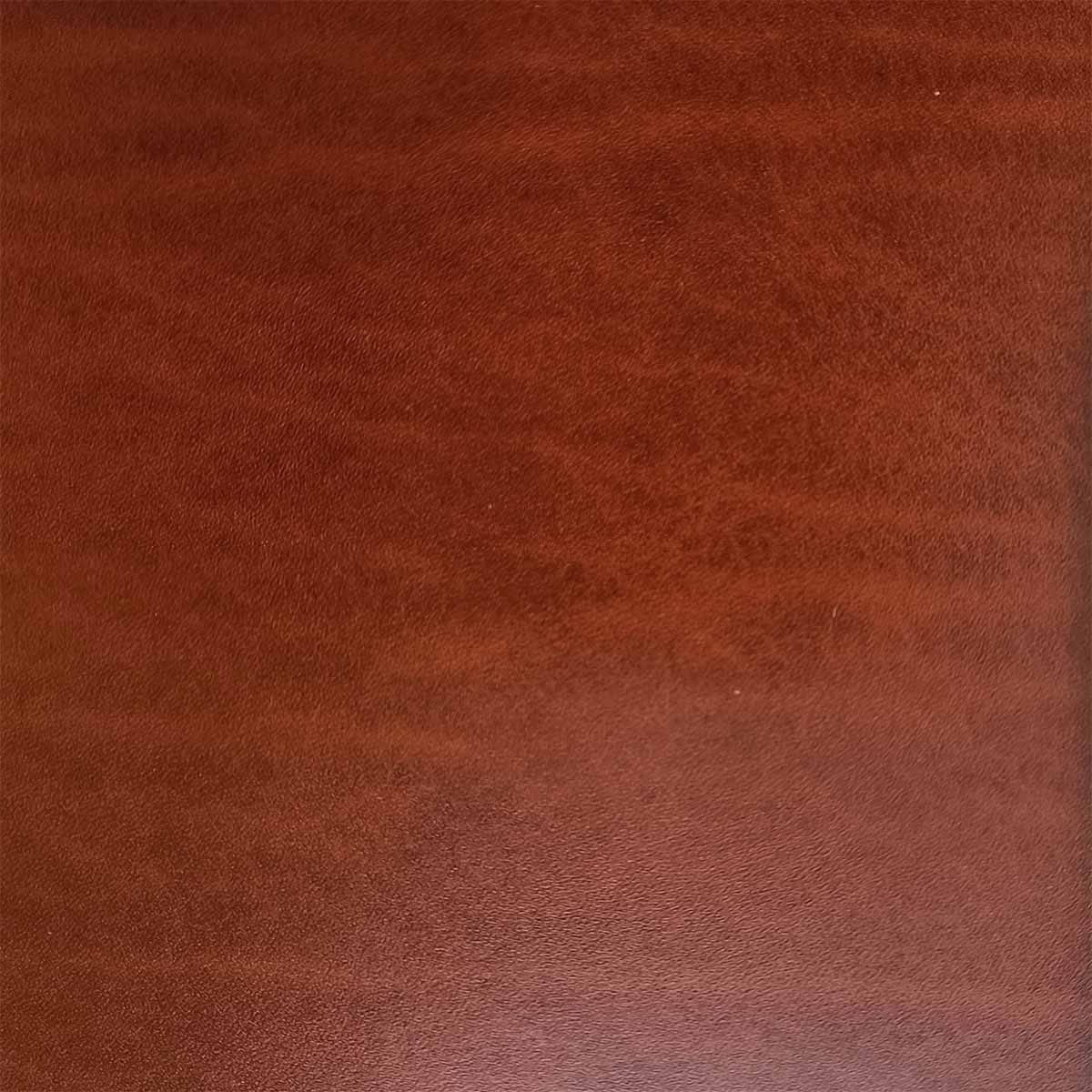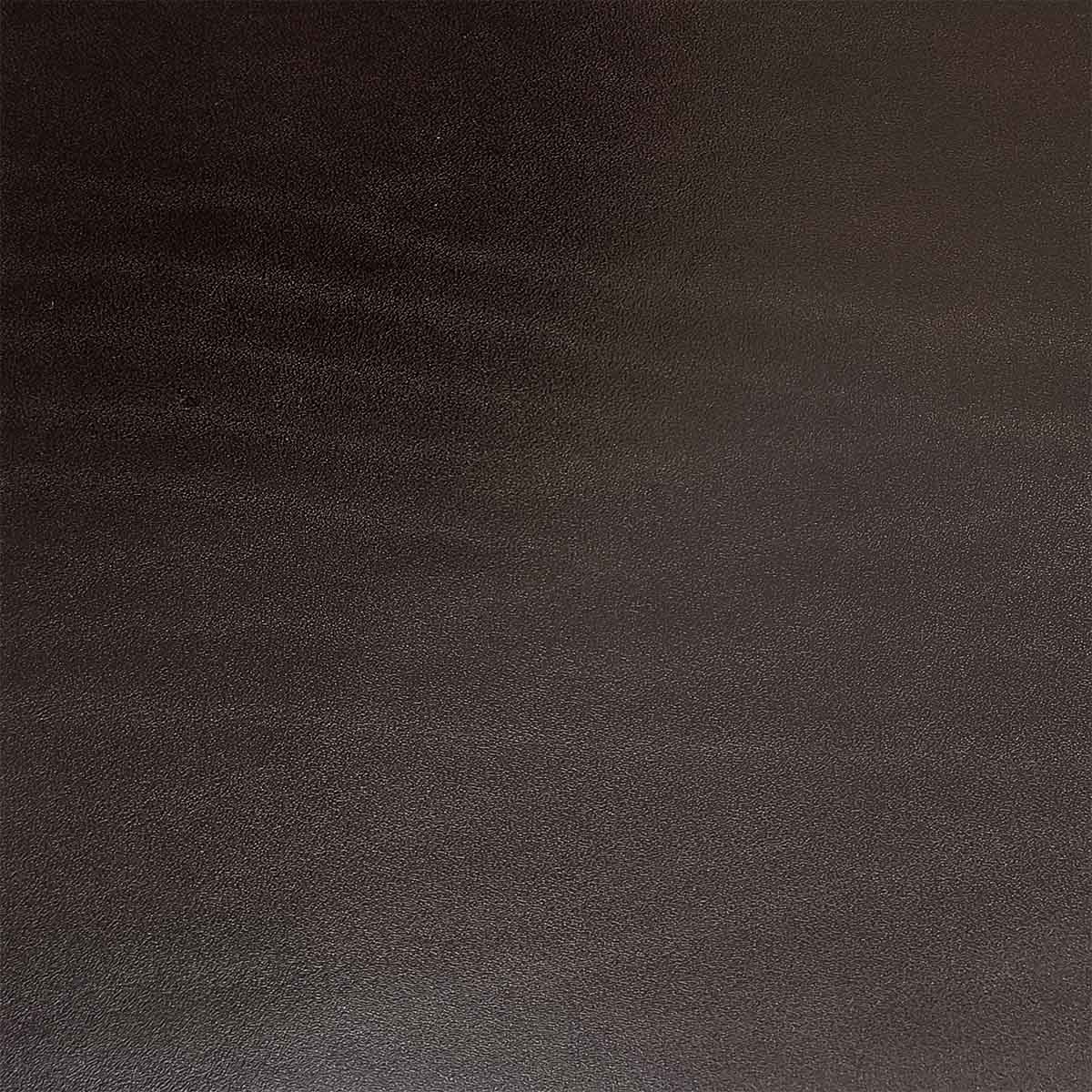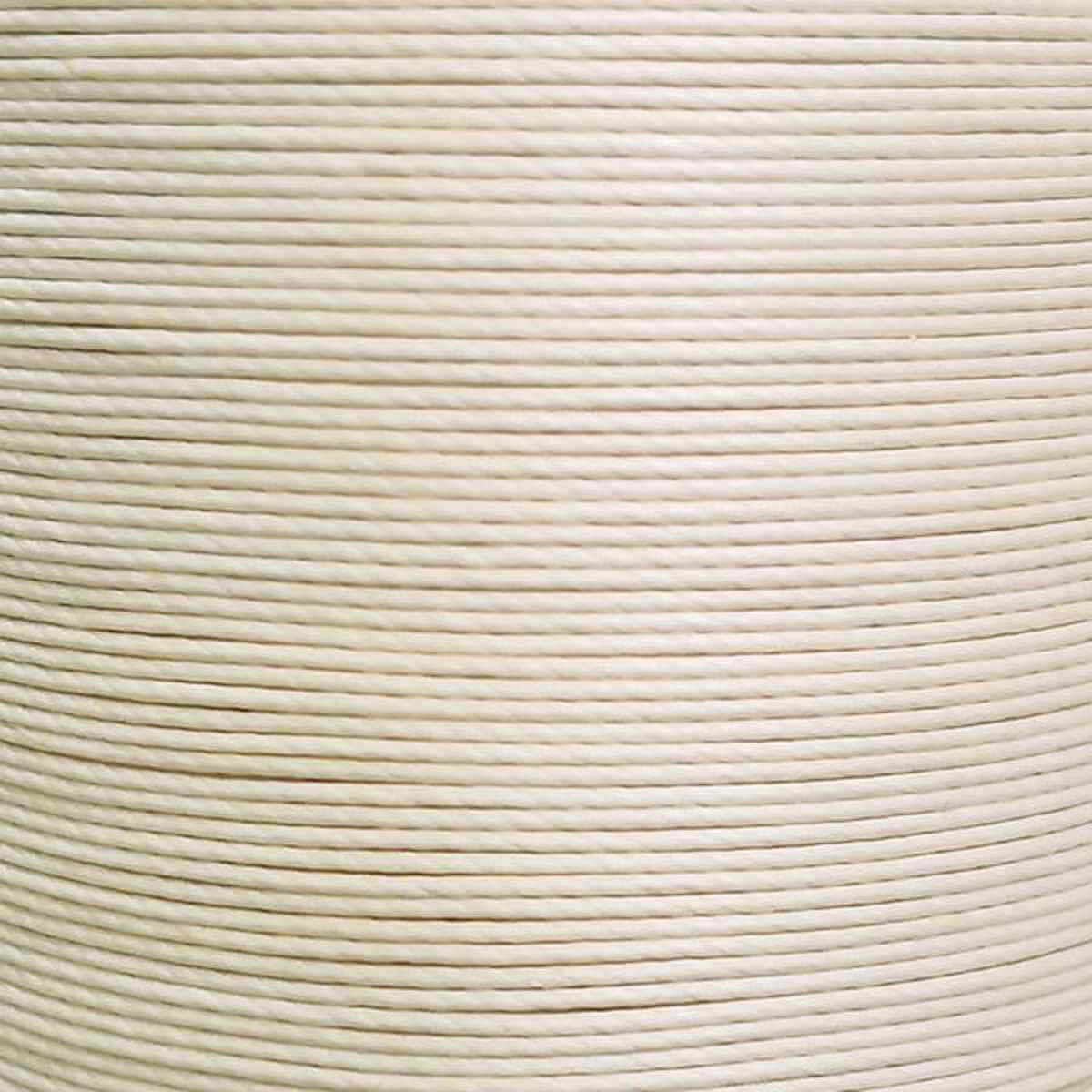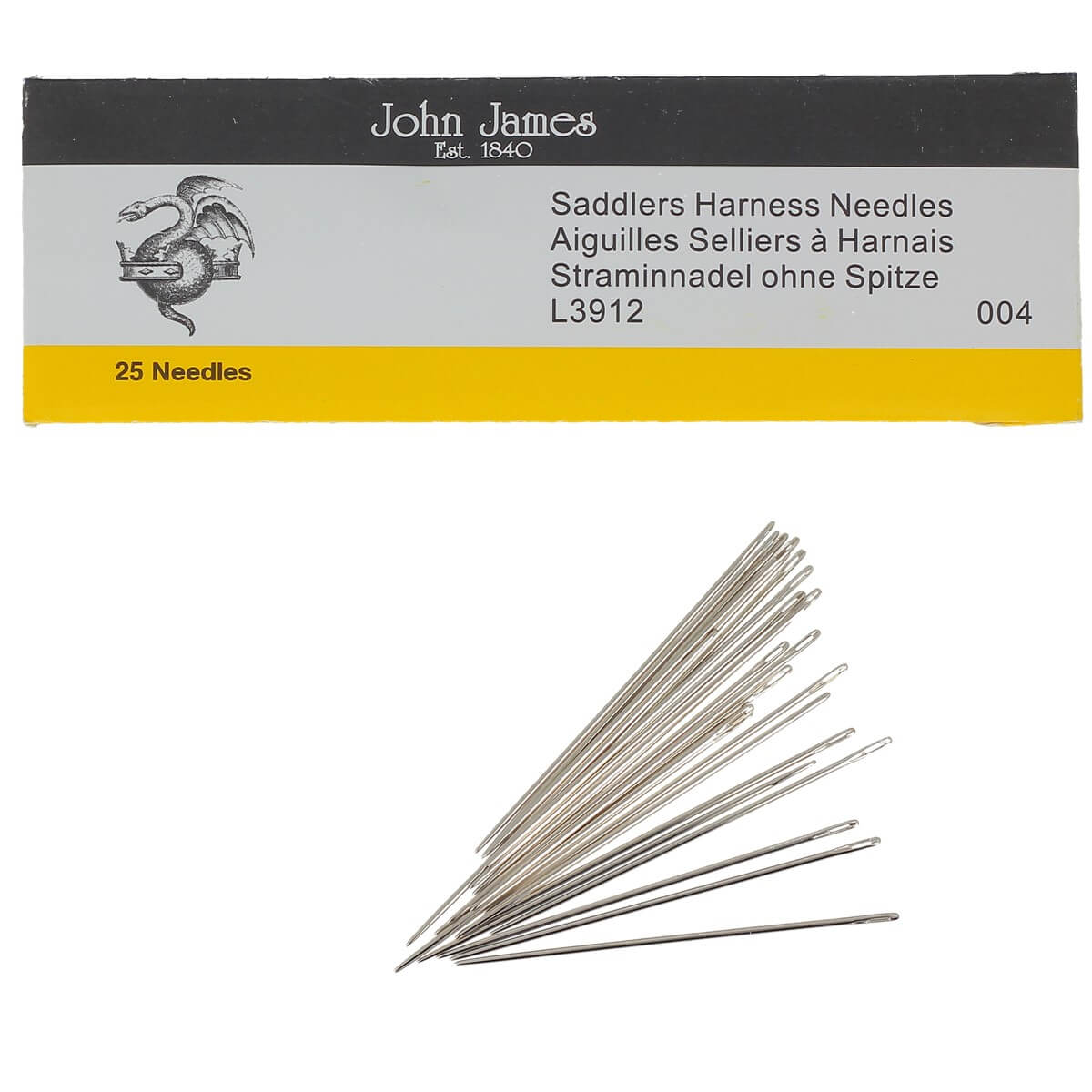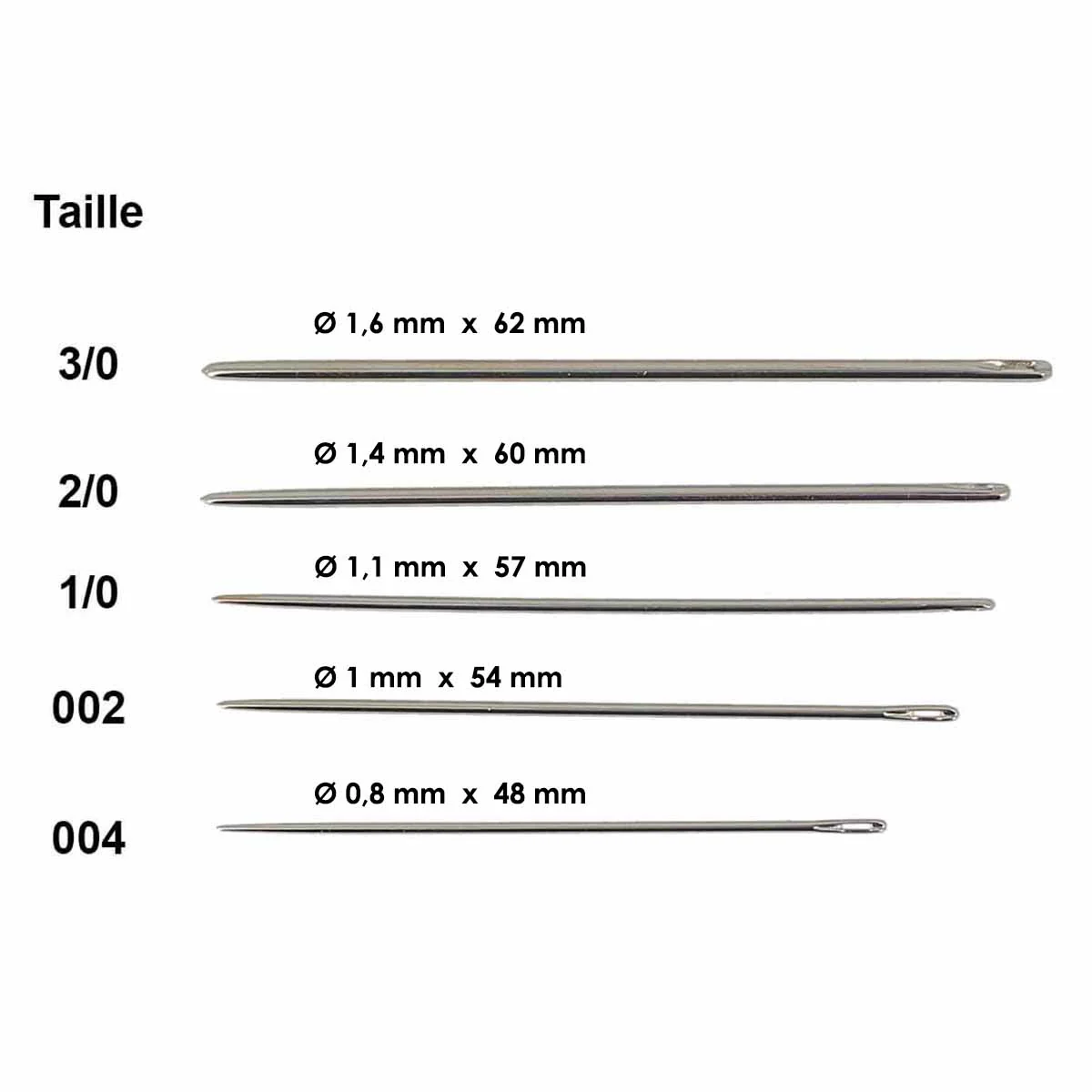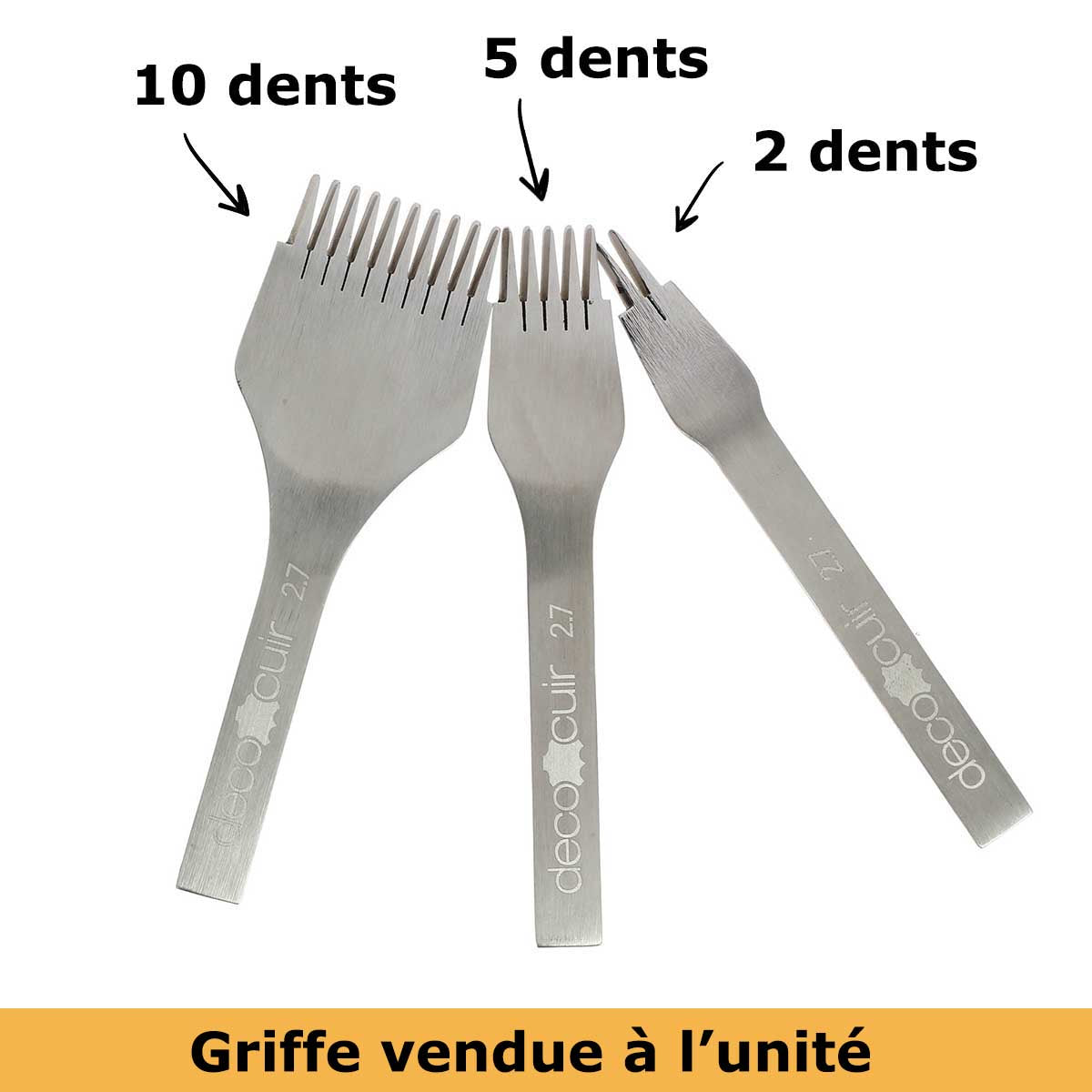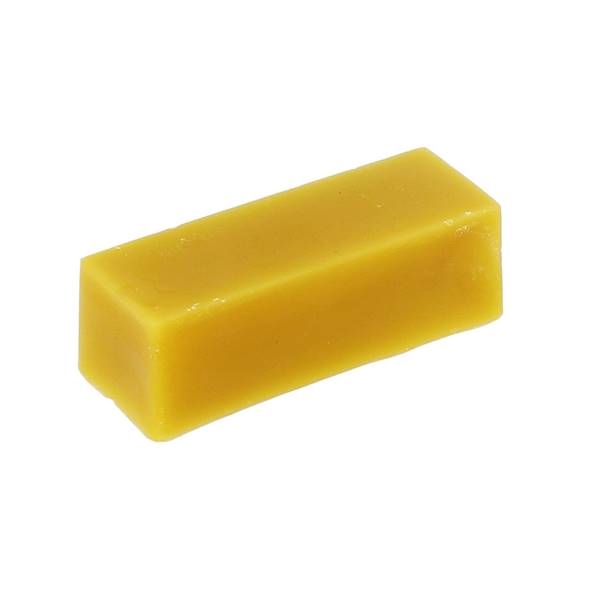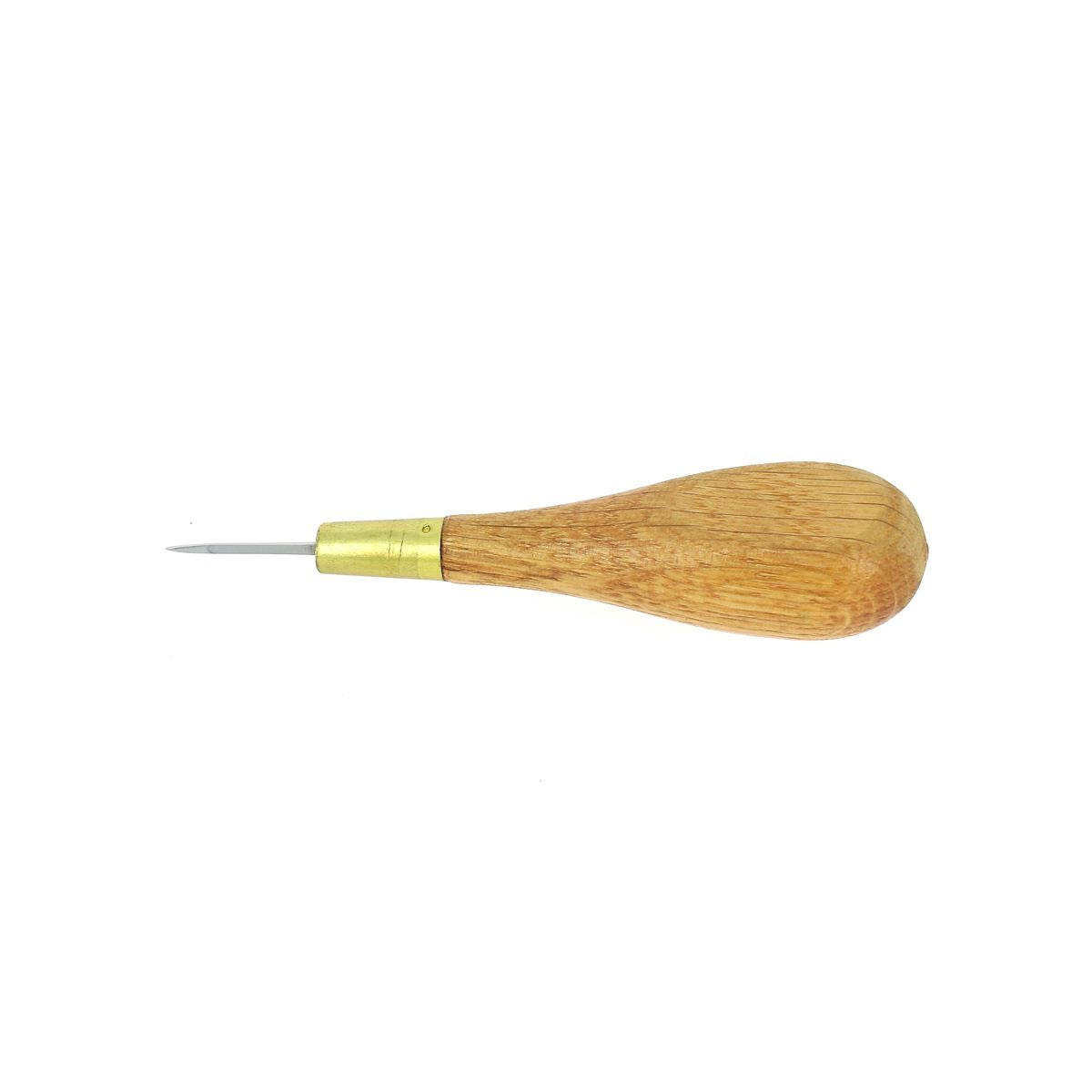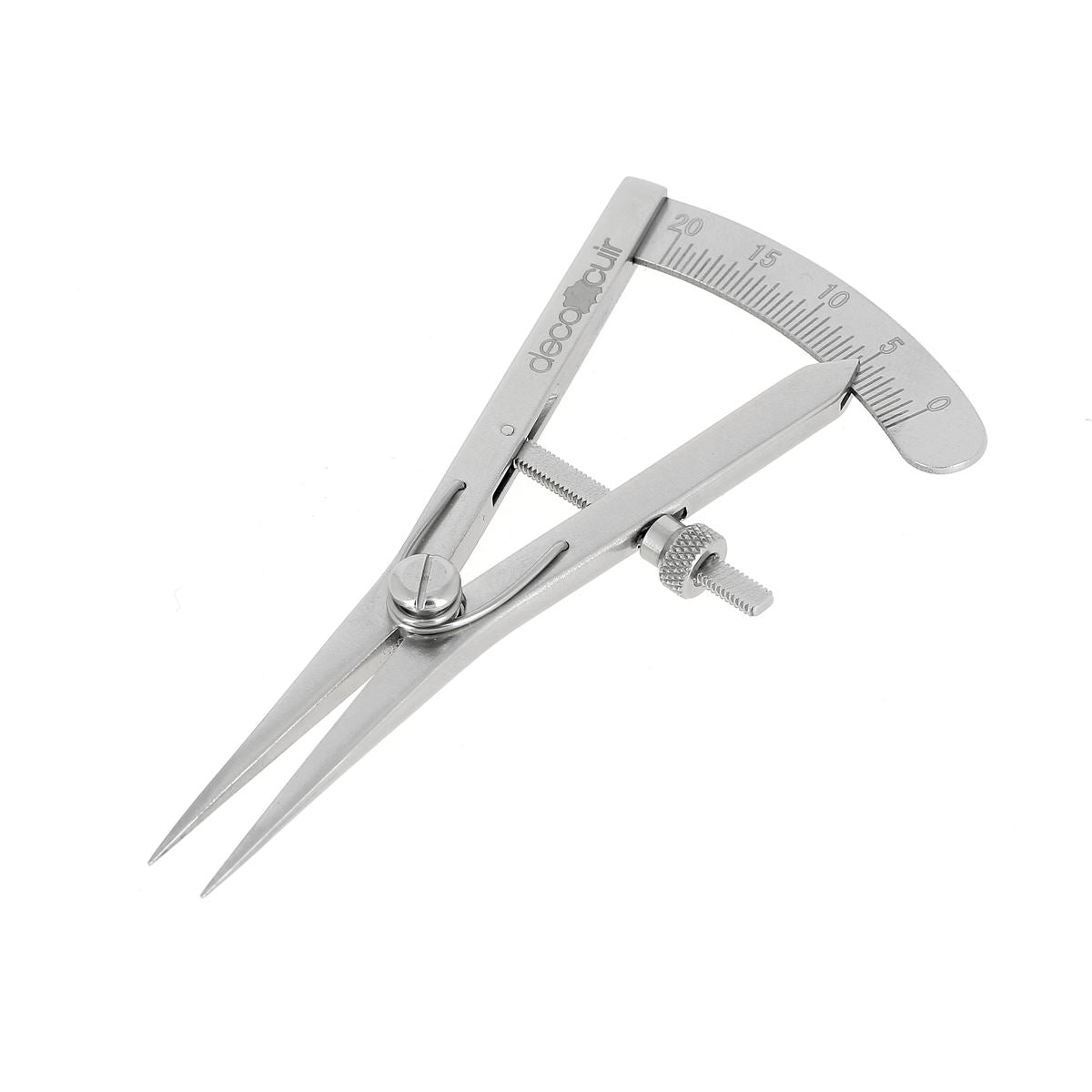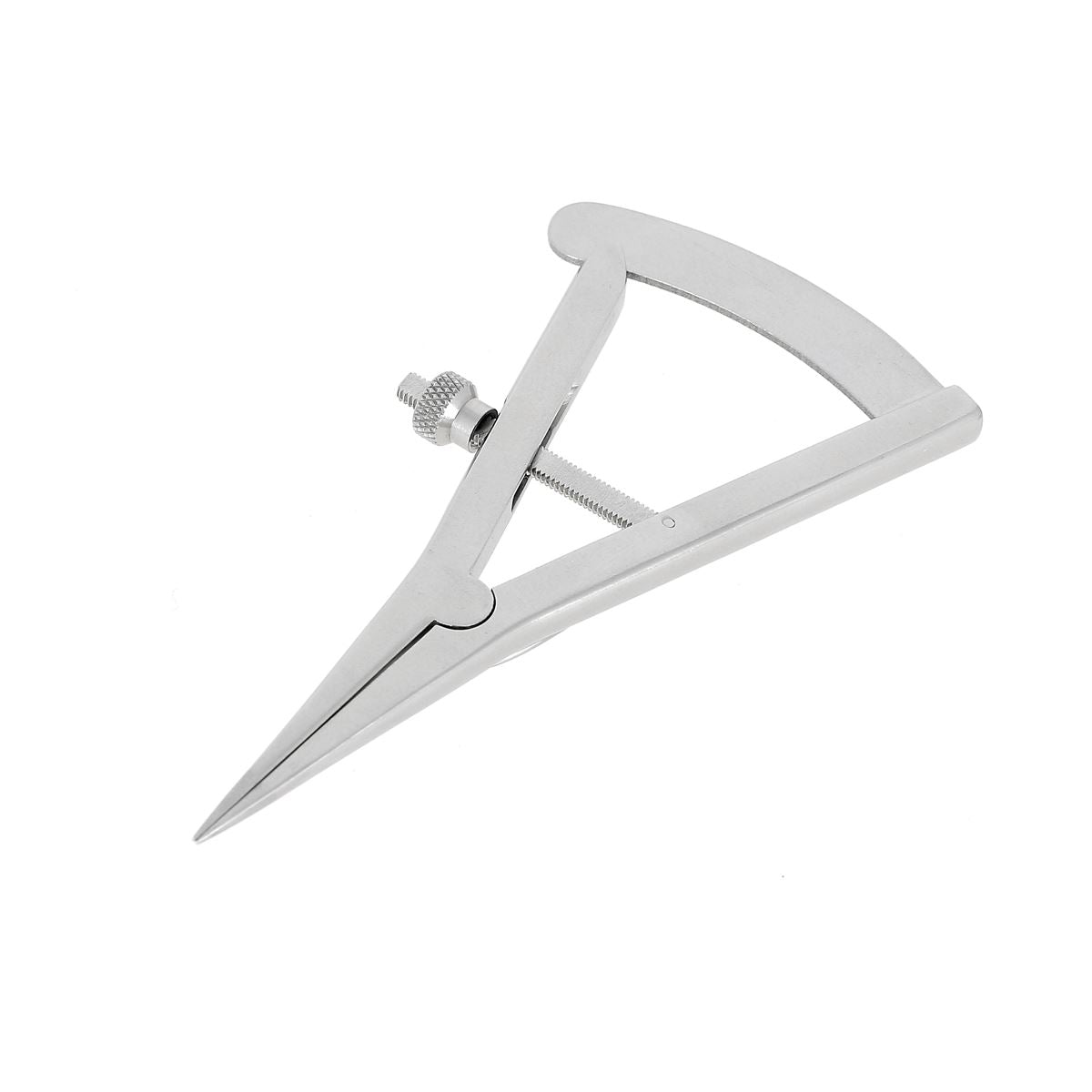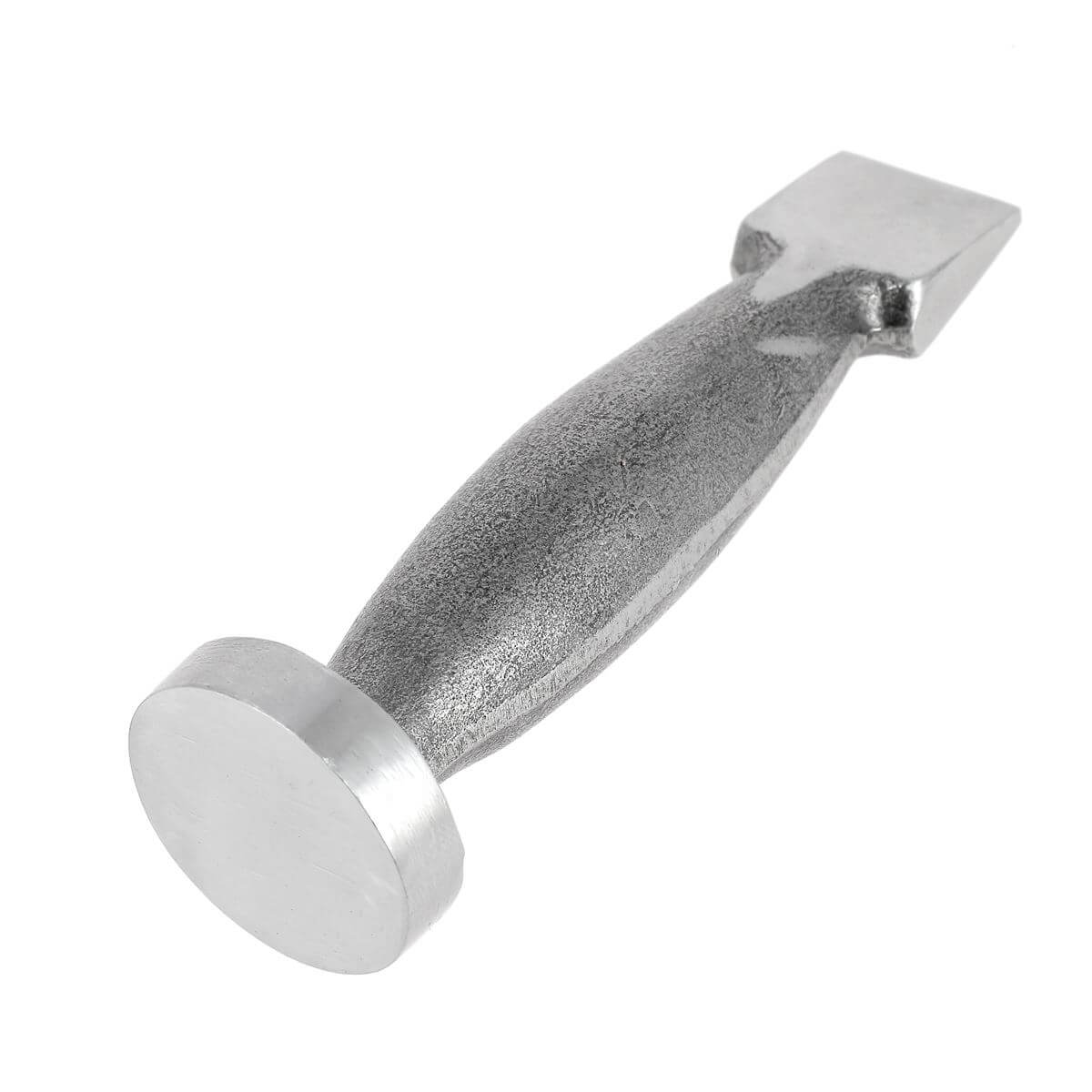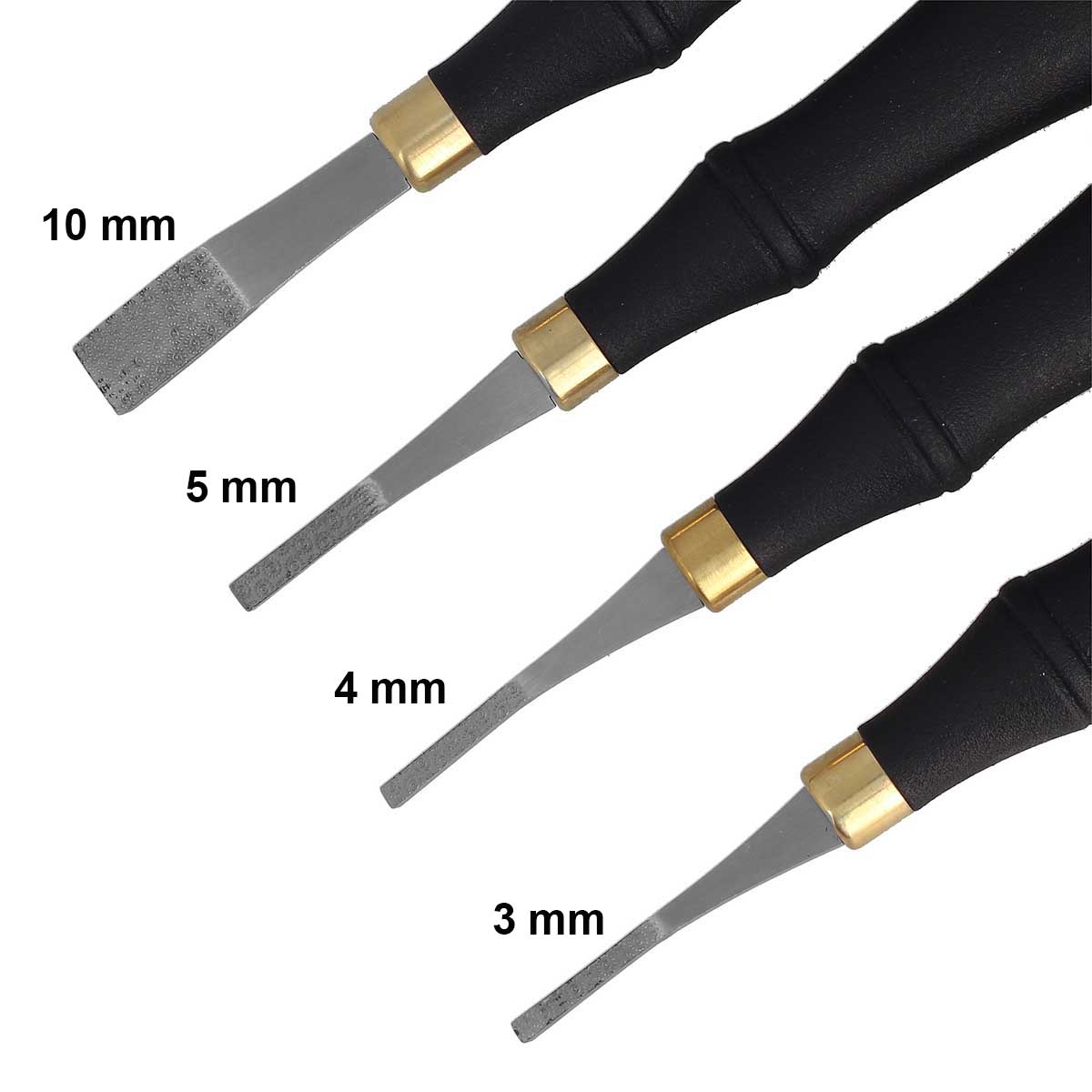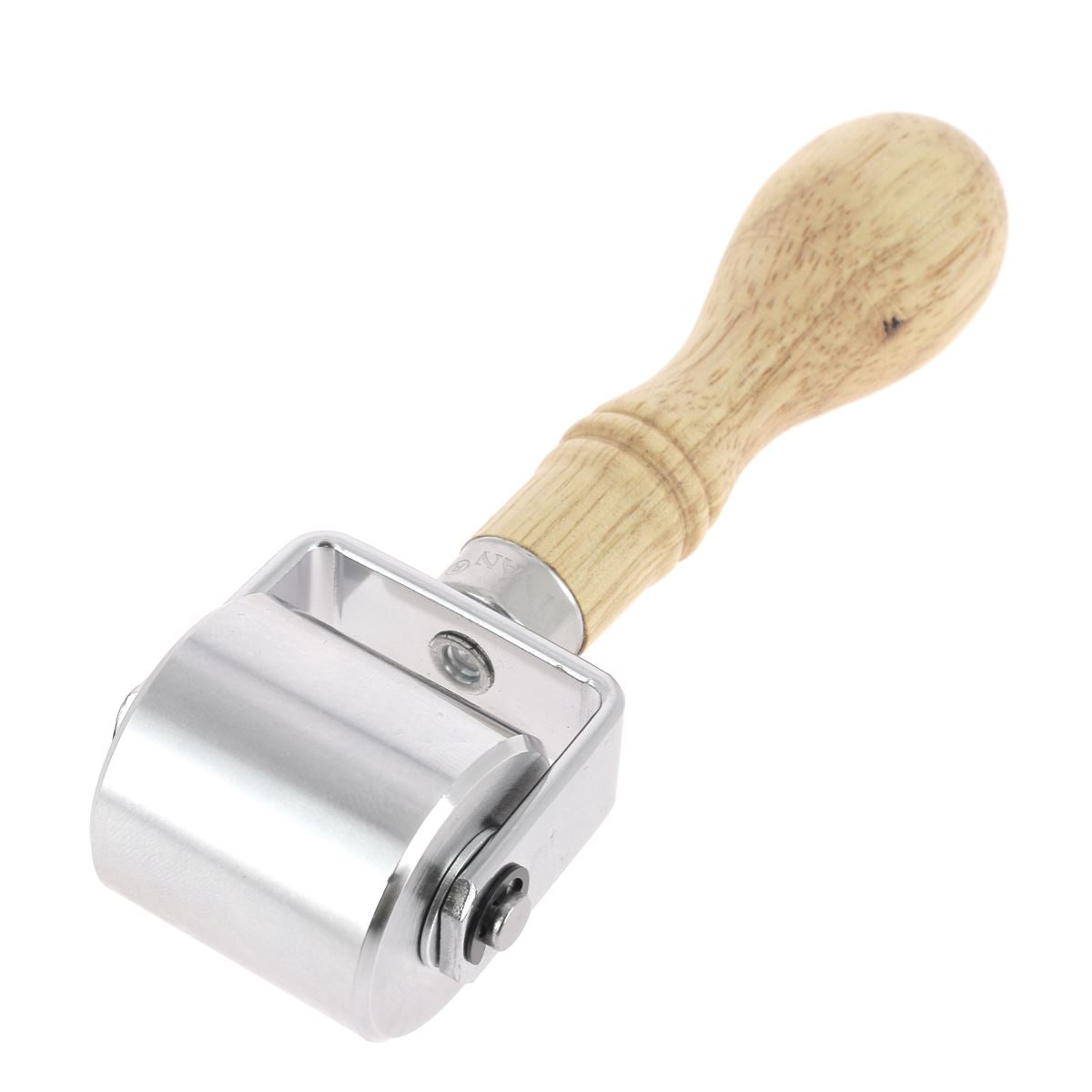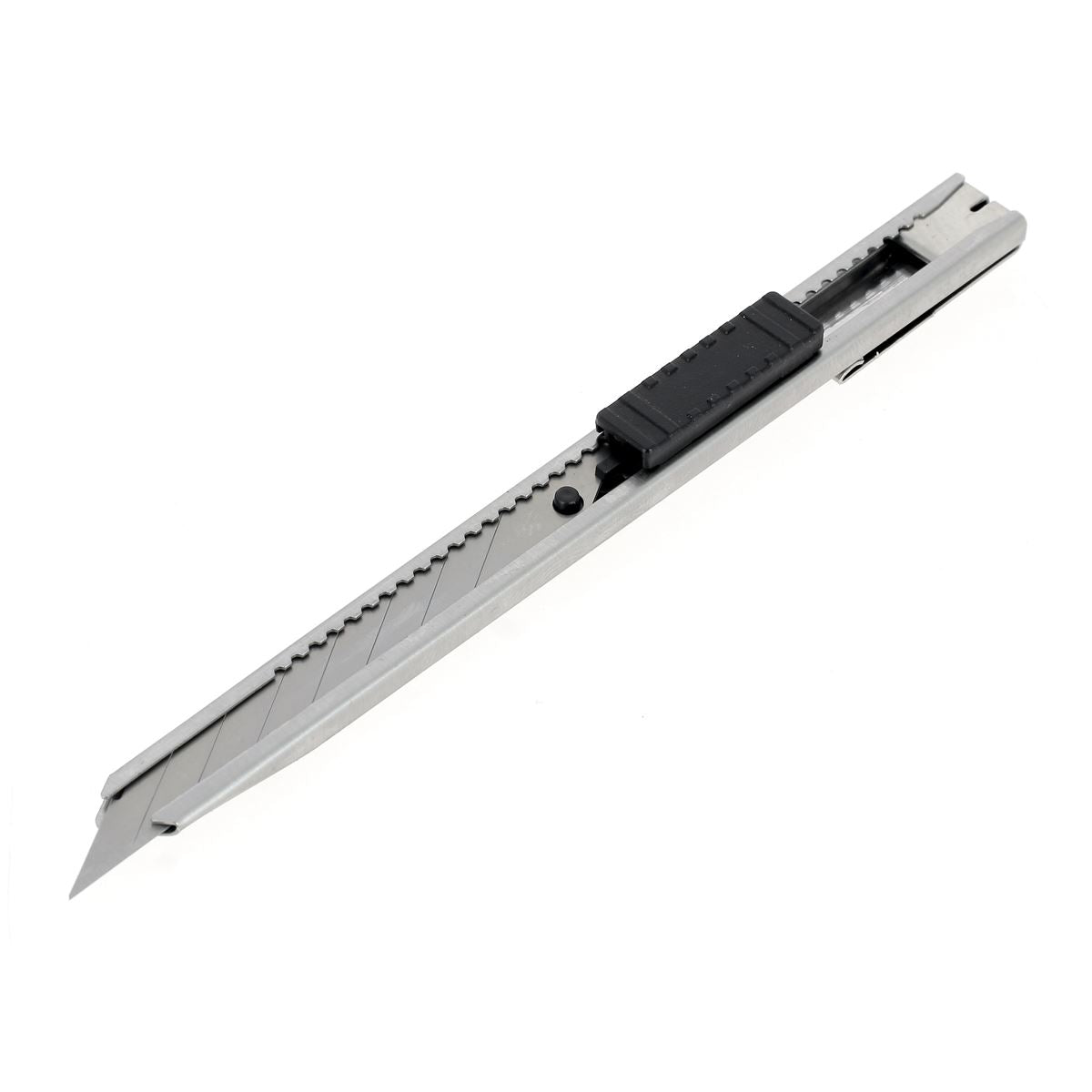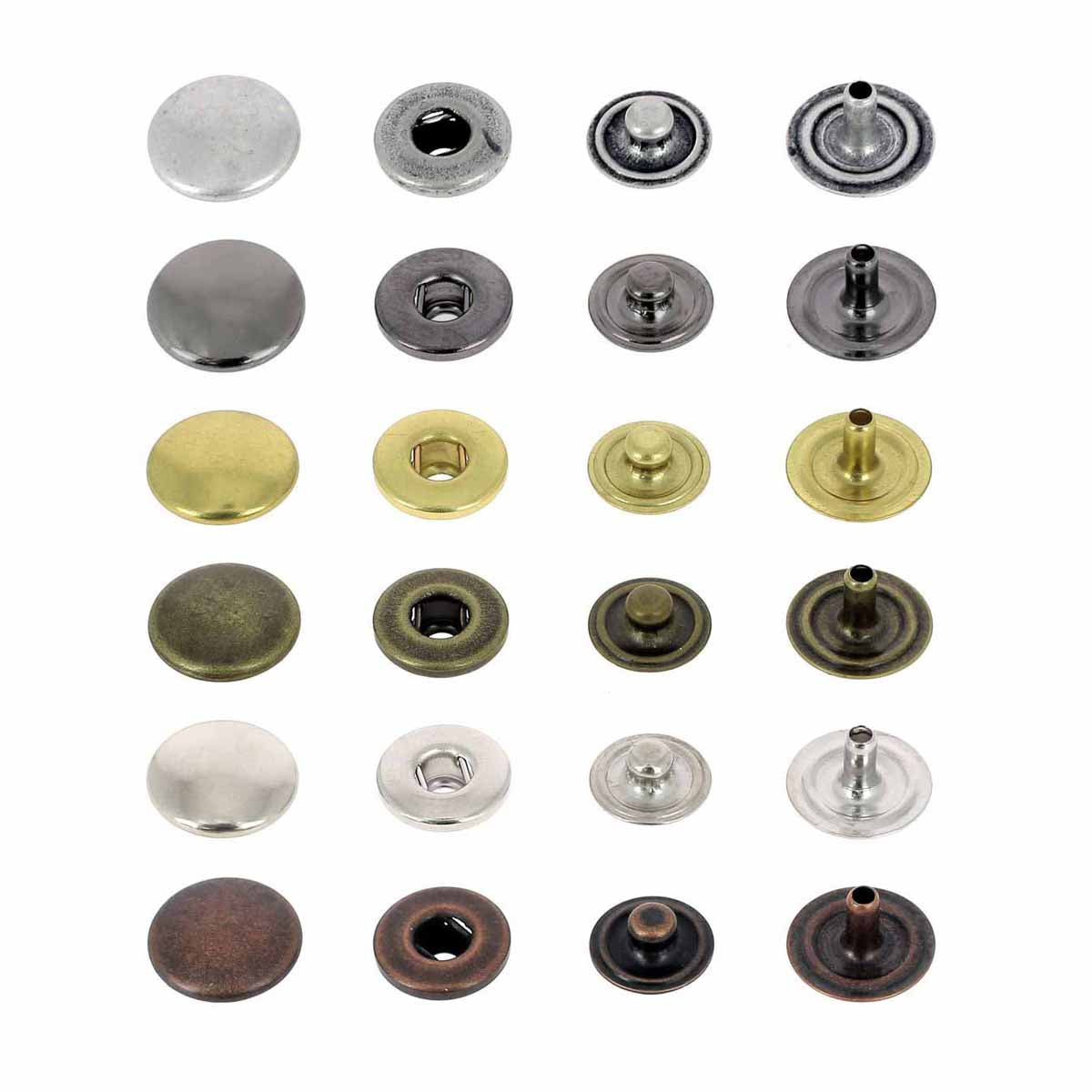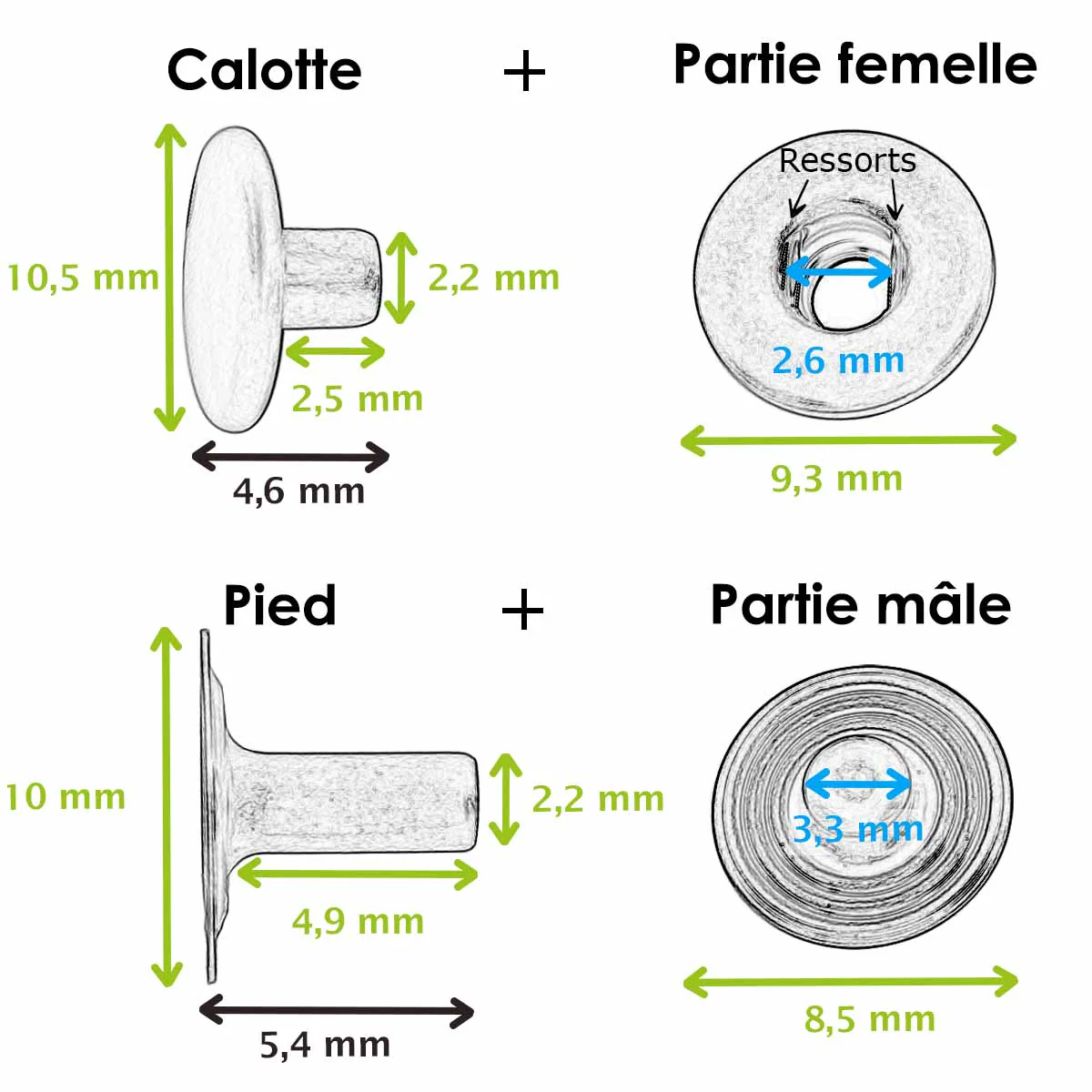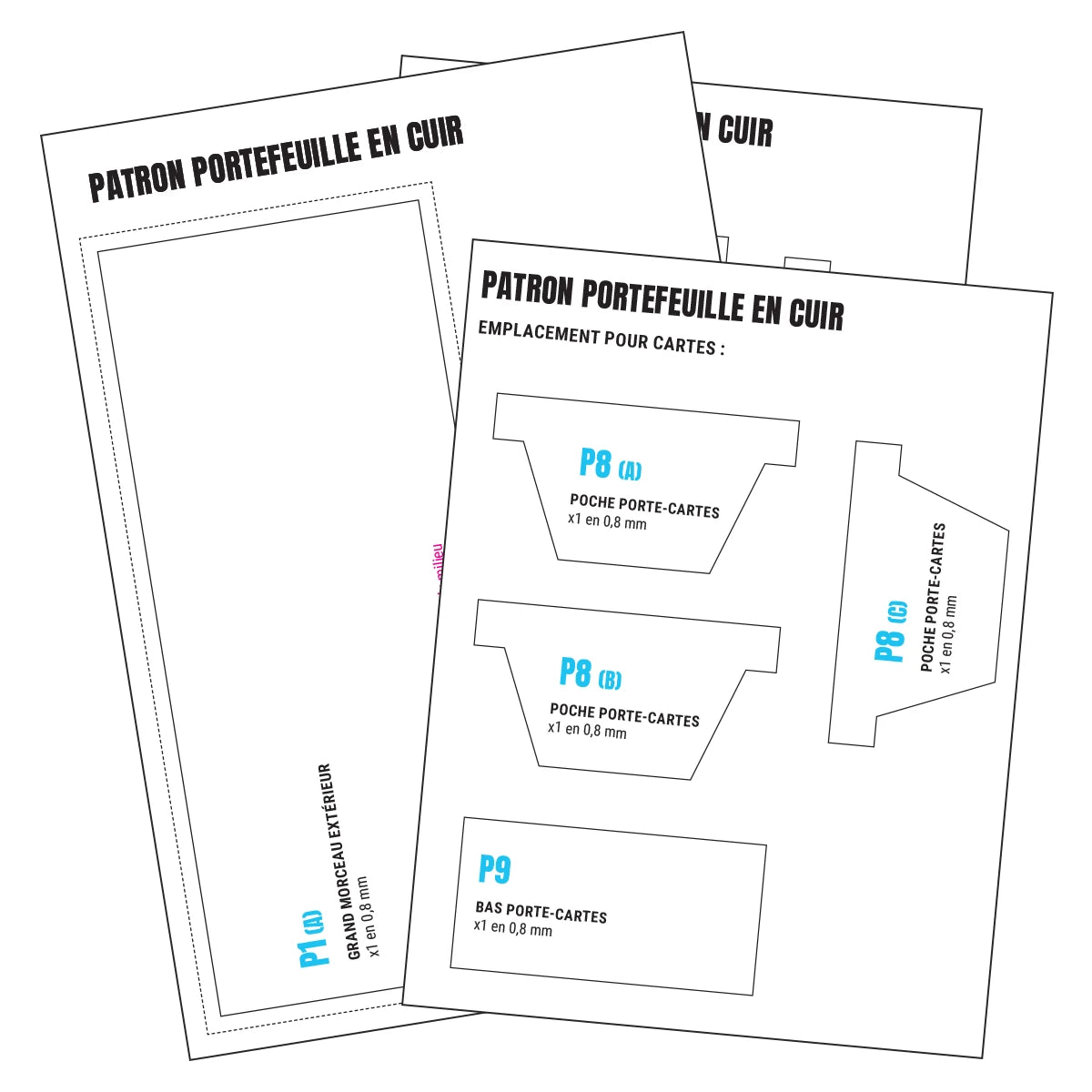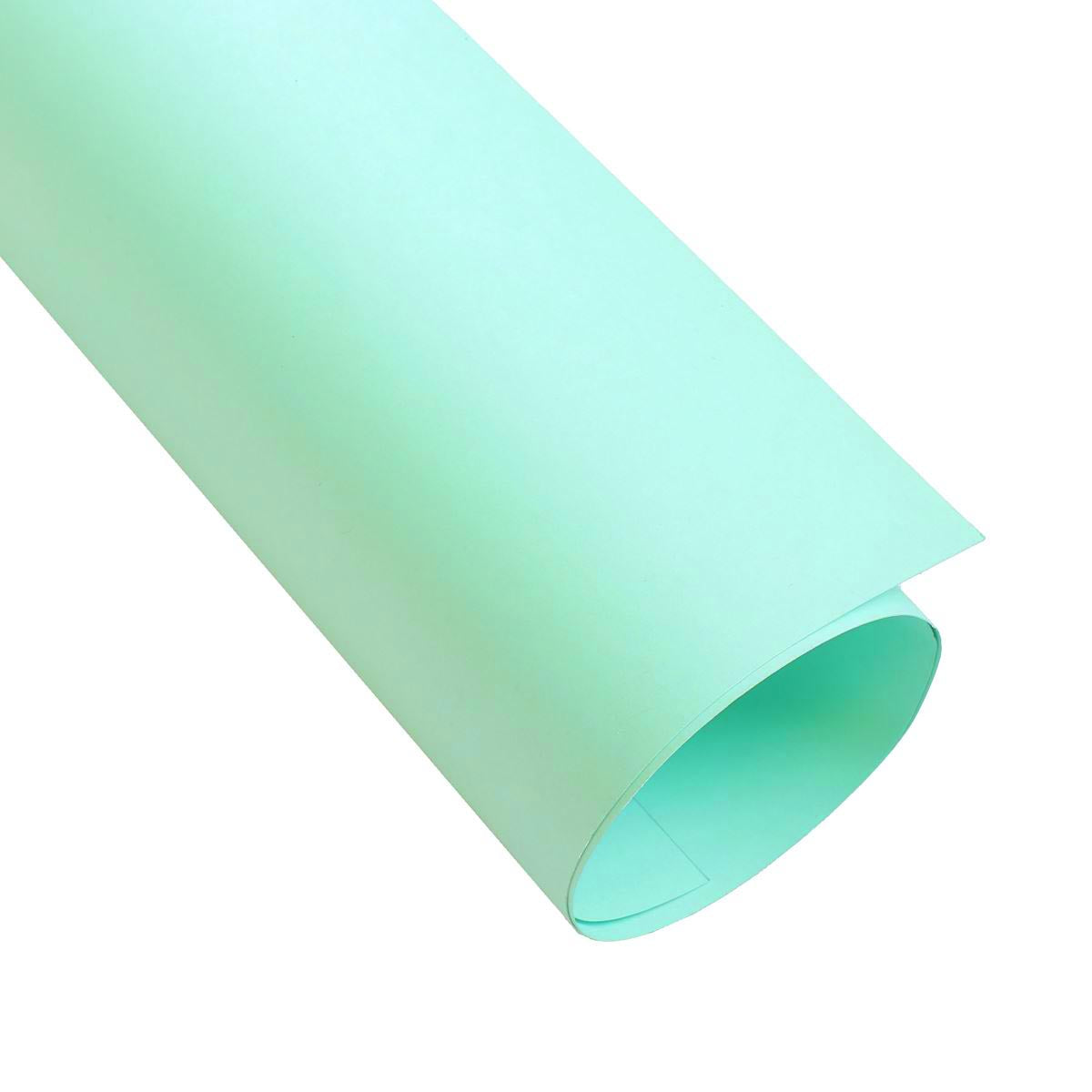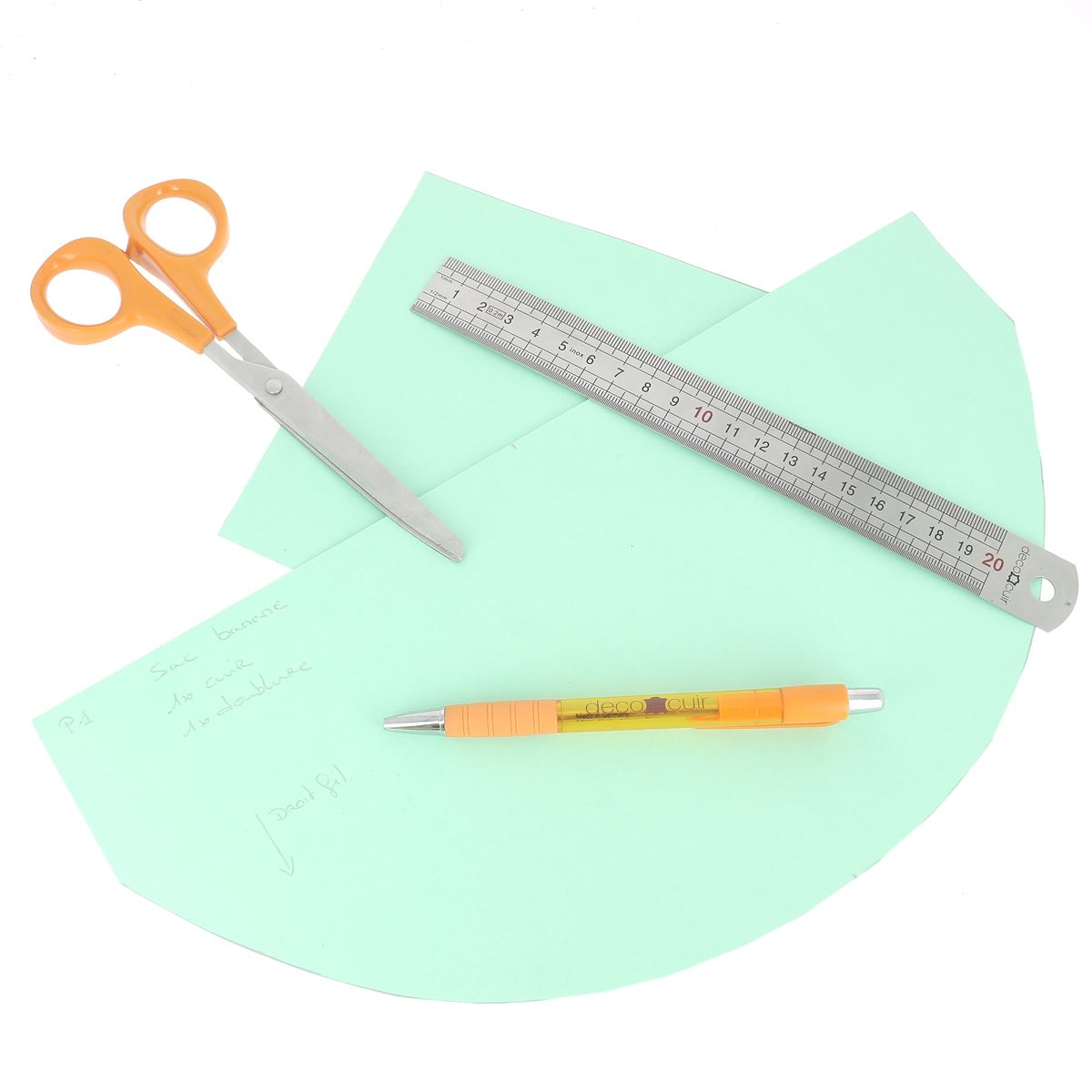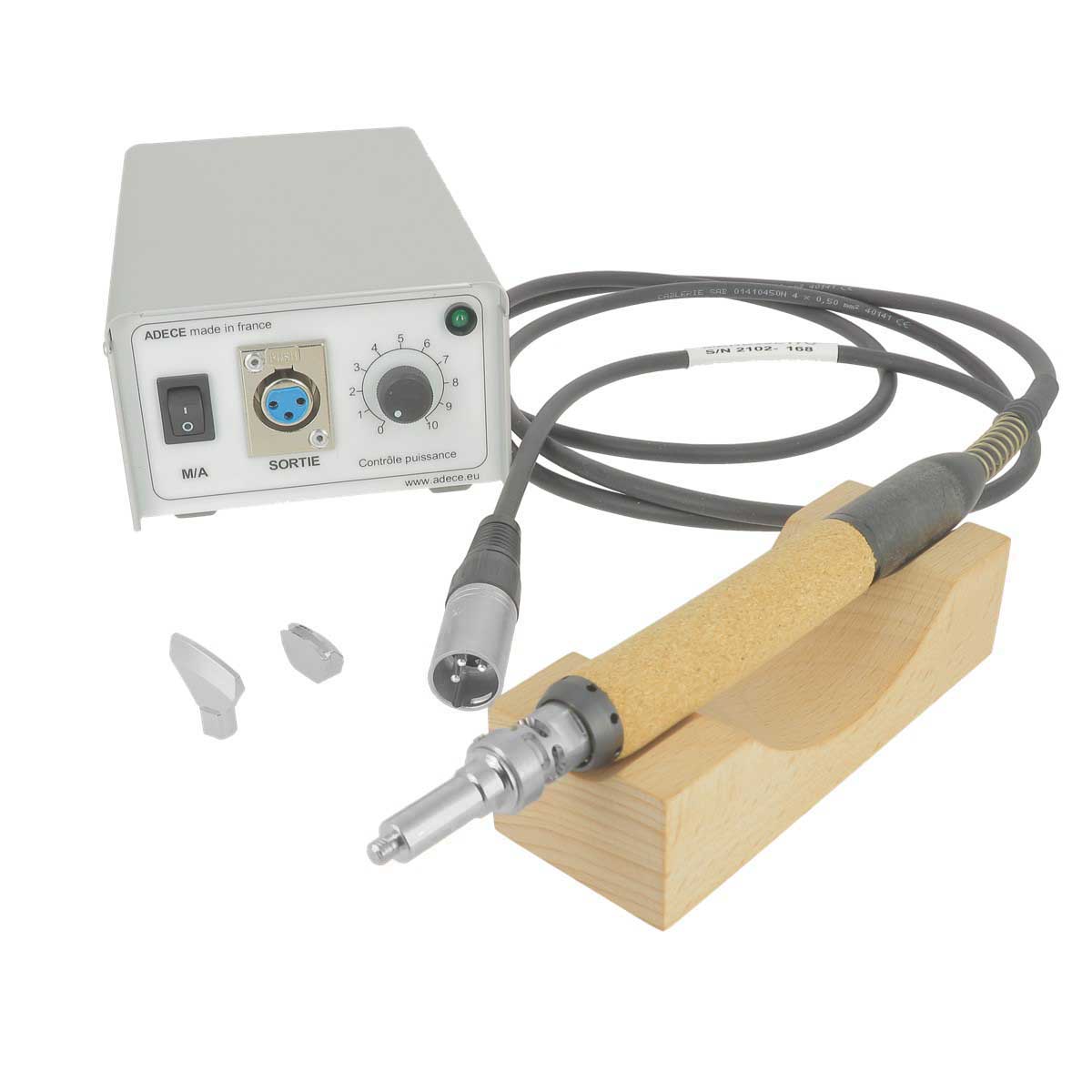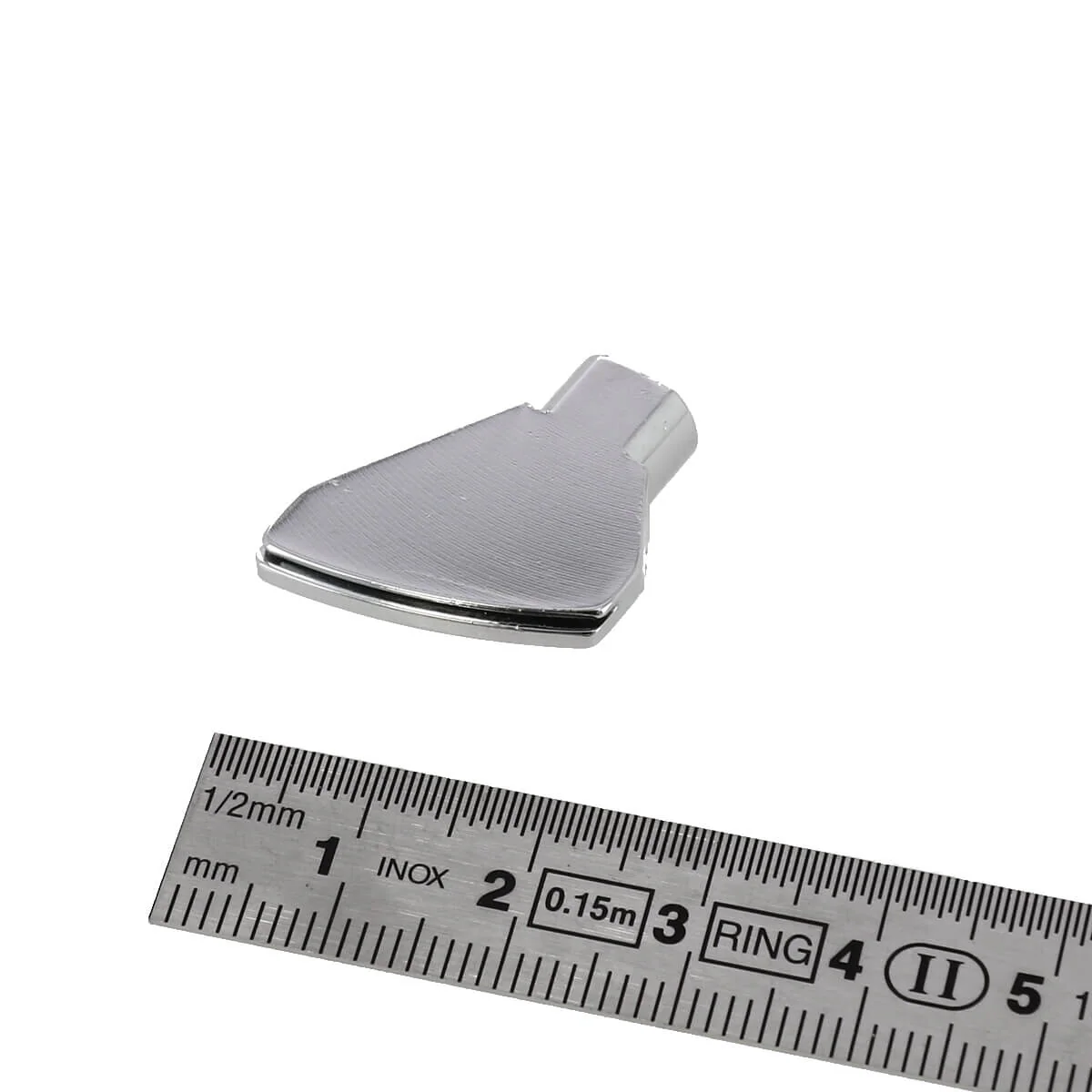
Choice of sewing
There are several methods for sewing leather wallet:
- By hand with saddle stitch
This method produces a very precise result and is ideal for this type of project. The saddle stitch is particularly popular with leather craftsmen because it is the strongest and most durable stitch.
- By hand with simplified (hole) stitching
Simplified hand sewing involves punching holes with a round punch. This technique, which uses straight stitches, is perfect for beginners because it's simpler to achieve while still remaining aesthetically pleasing.
- To the industrial machine
For those who prefer machine sewing, it is recommended to use an industrial sewing machine, especially with vegetable-tanned leather. This method is the fastest, but you must pay attention to the thickness of the leather and the machine's capacity to handle it.
If industrial machine sewing is chosen for vegetable tanned leather , it will be necessary to make the last stitch by hand. Indeed, this last stitch is difficult to achieve even with an industrial machine, due to the thickness and rigidity of the leather.
Also be careful, machine sewing can mark vegetable tanned leather.
Choice of leather
To make this wallet, it is recommended to choose a leather that is both semi-soft and semi-firm, or a firm leather. There are two main types of tanning: vegetable and mineral.
You will also need two different thicknesses of leather:
- A thickness between 0.8 mm and 1 mm.
- A second, thinner one (mainly used for linings) , about 0.5 mm.
Deco Cuir offers pieces of split leather, perfect for this type of project.
Our selection : In this tutorial, we have selected the range followed by Satinlys leather for the mineral tanning example. Satinlys leather is ideal for this project because it offers a good compromise between suppleness and firmness. We used 0.5 mm thick pieces of leather for some pieces and 0.8 mm pieces for others.
For the vegetable-tanned example, we chose leather from the Sauvage range , 1 mm thick. Due to the thickness of this leather, we reserved it for part P1 (exterior). For all other parts, we opted for natural vegetable-tanned leather, 0.5 mm thick.
THE NECESSARY MATERIALS
Mineral tanning version:
- 3 pieces of SATINLYS leather - CHESTNUT 20 x 30 cm - thickness 0.5 mm
- 1 piece of SATINLYS leather - CHESTNUT 30 x 40 cm - thickness 0.8 mm
- 1 piece of SATINLYS leather - CHESTNUT 15 x 20 cm - thickness 0.8 mm
Cost: approximately €30.00
Vegetable tanned version:
- 4 pieces of natural vegetable tanning 20 x 30 cm - thickness 0.5 mm
- 1 piece of SAUVAGE vegetable tanned leather 20 x 30 cm - thickness 1 mm
Cost: approximately €45.00
Hand-sewn version only:
- 2 cartons or 1 spool of MeiSi super fine waxed linen thread M40 - ⌀ 0.45 mm
- 2 saddle needles - Round tip - John James - ⌀ 0.80 mm (size 004)
- 1 drypoint compass
- Striking claws, center distance 3.38 mm
- 1 block of wax
- 1 saddle clamp or a sewing valet
- 1 round awl
- 1 awl with pliers
- 1 joiner's hammer / riveter's hammer
Hardware list for all versions:
- 1 brass snap fastener - Ø 10.5 mm + its installation tool
- 1 precision leather rasp file - 4 mm
- 1 pot of neoprene glue
- 1 steel roller - Smooth wheel for pressing leather - Ivan
- 1 square lampshade - Deco Cuir
- 1 cutter 9 mm blade 30° stainless steel
- Edge finishing: a pot of edge dye (if mineral tanning) or tokonole (if vegetable tanning).
GET THE BOSS
The wallet pattern is available for sale on our website (reference KA210). It is only available in digital format: a PDF to print in actual size and assemble.
We recommend reproducing the pattern pieces on pattern card.
FULL TUTORIAL VIDEO
PART 1: CUTTING
1. Cut out and transfer the paper pattern
Cut out the pattern and then hold it, with masking tape or a weight, on the pieces of leather, respecting the indicated thicknesses.

2. Cut out the pattern pieces
Cut out pieces P1 and P2 on the dotted lines of the pattern (cutting margins) before laminating and overcutting them.

Then, glue the two P1 pieces together, wrong side to wrong side, using contact glue (here neoprene) .

Press the leather to flatten the collage well.

Then cut out the pattern for piece P1 from this doubled rectangle.

Proceed with the same steps for the P2 parts.
For the other pieces : cut with a cutter following the pattern lines except for P4 and P7 (B) which must be cut on the dotted lines - cutting margins (these are lining pieces which will be recut).

For part P2 (A ): use a round awl to mark the four blue dots on the pattern. These marks will be used to determine where to stick the pocket in the following steps.

For part P7: Use a round awl to lightly mark the blue lines on the pattern. These marks will help you glue the card holder pockets (parts P8) correctly.

Note: do not immediately drill the Ø3 mm hole for the snap fastener.
PART 2: THE CARD HOLDER
3. OPTION: make decorative nets
Make decorative fillets on the top of pieces P8 and P9, 1.5 mm from the edge.
For mineral tanned leather:
The thread must be made hot, using a threading iron.
For vegetable tanned leather:
The thread can be made cold with a frog, a dry point compass or a former… or hot with a threading iron.


4. Work the slices
Work the top edges of pieces P8 and P9 (the length with the decorative fillet). Use an edge dye for mineral-tanned leathers and Tokonole for vegetable-tanned leathers.

SEE THE GUIDE TO THREADING IRON AND WORKING SLICES
5. Trim the corners
To avoid excess thickness at the card holder level, we recommend lightly trimming the corners of parts P 8 and P9.
 |
 |
6. Mount the card holder
To help the glue adhere, scrape the grain of the leather on piece P7(a), at the level of the pink lines indicated on the pattern. Be careful not to scrape higher than the lines.

Glue the first piece P8 by applying glue to the bottom of the piece as well as to both sides. Also apply contact adhesive to the piece P7, 1.3 cm from the top.
See photo ⬇️

Glue part P8 onto P7, making sure that it is 1.3 cm from the top of part P7.

Sew the bottom of piece P8 to P7. Two options for sewing :
- Hand sewing with saddle stitch
Using a dry point compass, draw the seam line 3 mm from the edge at the bottom of piece P8.

Mark the stitching points with a punching claw.

Sew with a saddle stitch.

SEE THE SADDLESTITCH SEWING GUIDE
- Sewing with a sewing machine
To save time, it is possible to sew this part with a sewing machine.

Do the same with the other two P8 pieces.

Glue part P9 to the bottom of part P7.
 |
 |
7. Glue and sew the right side of the card holder
Once all the parts are glued, take the second piece P7(b). Glue the two P7 pieces together, wrong sides together, with contact adhesive.
 |
 |
Overcut.

Sew the right side of the card holder (by hand or machine) .
You only need to sew the right side because the other three sides will be sewn later, during the final assembly of the wallet.
If hand sewing:
Using a dry point compass, draw a line 3 mm from the edge of the right side of the part.

Mark the stitching points with a punching claw.
IMPORTANT : To avoid weakening the sides of the card holder, be careful not to mark the stitches at the intervals. We recommend using a two-pronged claw and offsetting the stitches if necessary to position them correctly between the different pockets of the card holder.

Sew with a saddle stitch.
 |
 |
8. Work the slice
Work the edge that has just been sewn. Overcut if necessary, sand and apply an edge finish.
 |
 |
9. Grate the back side
Turn the card holder over and smooth the three remaining sides on the back of the card holder. This will make it easier to glue it to part P2 in the following steps.

PART 3: THE WALLET
For those who never carry change, it is possible to make another side a card holder rather than a coin pocket.
10. Place the Ø10.5 MM snap fastener
There are 2 options for installing the snap fastener:
|
CHOICE 1: SHEATHED BUTTON
|
CHOICE 2: HIDDEN BUTTON
|
 |
 |
Choice 1: Sheathed button
For a discreet and refined snap fastener, it is possible to cover it with the same leather as that used for the wallet.
Here are the steps to follow:
1. Start by laminating the P4 lining to the intended location on the P3 piece, wrong sides together. And overcut.
 |
 |
2. Drill Ø 3 mm holes on parts P3/P4 as well as on part P5.

3. Place the press stud foot on part P5.

4. Cut out a small square of leather measuring 5 x 5 cm, with a maximum thickness of 0.5 mm. Apply contact adhesive to the back of this square.

5. Let the glue dry for a few moments, then lightly sand the head of the snap fastener to improve adhesion.

6. Place the head of the snap fastener in the center of the leather square, then fold the leather towards the inside of the snap fastener.
 |
 |
7. Using thread, wrap the thread around the snap fastener shank several times to stretch the leather toward the inside of the snap fastener. Pull very tightly and tie a knot.
Allow the glue to dry for several hours (or even a whole day) to ensure a good hold.
 |
 |
8. Once the glue is dry, use a cutter to cut off the excess leather at the head of the snap fastener . Using your fingernails, gently fold the edges of the leather inside the snap fastener.
 |
 |
9. Place the snap fastener in the location provided on part P3/P4.
 |
 |
Choice 2: Hidden button
For an invisible snap, it is possible to hide it in the lining at the top of the pocket. Here are the steps to follow:
1. Start by drilling the Ø 3 mm holes for the snap fastener only on parts P4 and P5. Ignore the hole on part P3.

2. Place the head of the snap fastener on part P5 (front of pocket), with the rounded part on the reverse side of the leather.
 |
 |
3. Then, place the press stud foot on part P4 only (flap lining).

11. Sew the flap lining
If you have opted for the hidden snap fastener in the lining (option no. 2): glue the P4 lining to the location provided on P3, wrong sides together. And overcut.

Using a dry point compass, draw the seam line 3 mm from the edge on the top width and on both lengths of piece P3, until the lining stops.

Mark the stitching points with a punching claw, across the width of the top and both lengths of piece P3, up to the lining stop.
Reminder: always start by working the corners with a 2-pronged claw: the rule is that the point located in the corner must always point towards the center of the room. It is also possible to mark the corner with a round awl.

Sew these three lengths.

Next, sew the remaining line of lining. Trace the line and mark the stitching points directly on the lining.
 |
 |
Strike the seams using a joiner's hammer or a riveting hammer.

12. Rounding the corners
Using a cutter, break the top corners of P3/P4.

Then, sand the slices with an abrasive sponge.

13. Grate the back of the pocket
Using a rasp, sand the remaining lines (the unsewn ones) on the right side of piece P3.
 |
 |
14. Sew the rest of the pocket
Using a dry point compass, draw the seam lines 3 mm from the edge of pieces P5 and P6.
Diagram of the lines where to draw the seam:


Mark the stitching points on these same lines.
Here, we will make a double stitch to sew the gussets on piece P5. This will allow for a nice stitch on both sides of the leather (given the thin thickness to be assembled).
Caution: When double-punching, slightly enlarge the holes with a round awl, not a tweezer awl. Be careful not to push the round awl too deeply to avoid shattering the holes made with the claws previously.

Glue the P6 gussets to the sides of P5, 3 mm from the edge. Wrong sides together.
 |
 |
Then, sew these two lines. 
15. Work the slices
Sand and apply edge stain or Tokonole to all edges of parts P5 and P6.

16. Glue the front of the pocket to the back of the pocket
Once the front edges of the pocket are dry, apply contact glue to 3 mm of the unlined sides of the P3 piece (on the back of the leather / flesh side) . And on the unsewn lengths of the P6 gussets.
 |
 |
Glue the front of pocket P5+P6 to P3 and tap the joint with a joining hammer. To properly form the gussets, fold them before gluing. Refer to the photos below.
 |
 |

17. Work the slices
Work the slices all around the pocket.
If this has not been done, make a decorative net on the front of the pocket (optional).

PART 4: THE INTERIOR
18. Prepare part P2(a)
Using a compass at 3 mm centers, draw the lines for the pocket location on piece P2 (a), indicated on the pattern.

On the inside line, mark the stitching points with a punching claw.

Then grate this area.

19. Glue the pocket on P2
On this same area, apply a bead of contact adhesive. Also apply adhesive to the scraped areas on the back of part P3.
 |
 |
Glue the pocket onto part P2(a) following the outer line drawn with the compass.

20. Sew the pocket
Sew the remaining lengths of the two gussets in double stitching (use the round awl) .

Then, sew the bottom line, taking the gussets into the seam.

21. Glue the card holder
Grate piece P2(a) where the card holder will be glued (see the pink hatched lines on the pattern).

Then, apply contact cement to these three sides and to the three unsewn sides of the card holder (where it was grated in step 9).

Glue the card holder onto part P2. Flatten the glue with a jointer's hammer.
 |
 |
22. Trace the seam lines
Draw a line 3 mm from the edge all around the P2 piece, the card holder and the pocket. Be careful not to make the sewing line on the area not to be sewn (middle area).
 |
 |
Caution : as in step 7, you must ensure that the stitches fall at intervals at the edges of the card holders: use a 2-pronged claw.

23. Option: make the decorative net
For a professional look: create a decorative border around the entire edge of the room.

24. Sew the top line of piece P2
Sew only the top line of piece P2 for now.

25. Grate the back of P2
To facilitate gluing with part P1, rasp the 3 remaining sides on part P2(b).

PART 5: THE EXTERIOR
26. Sew the main piece
Take piece P1 (large outer piece). Using a compass, draw the seam line 3 mm from the edge all around piece P1, except at the "Do not sew area" indicated on the pattern.

Using punching claws, mark the stitching points all around the P1 piece, following the stitching line (except on the area not to be sewn).

Make a decorative fillet 1.5 mm from the edge all around part P1.

Vegetable tanned version : square the edges all around the P1 piece.

Sew only the top length of piece P1.

27. Work the slice
Work the edge of the length that has just been sewn. Sand, then apply an edge dye or tokonole depending on the leather chosen.

28. Grate the leather
Using a rasp, scrape the leather (interior, lining) on the parts that will be glued later. That is to say: the two widths, then the length of the bottom of piece P1, except for the area not to be sewn.
 |
 |
PART 6: FINAL SEWING
29. Glue parts P1 and P2
Apply contact adhesive to the areas that were grated on part P1 and part P2(b). Be careful not to get any adhesive on the area that is not to be sewn.

Glue the two pieces together.
 |
 |
30. Sew pieces P1 and P2
The leather is already scored on each side, all that remains is to sew.
Hand sewing version : be careful, you must use the double-stitching method (to have a nice seam) : pierce the leather on both sides (with the same claws) and then pierce the stitching points with a round awl (using a diamond-shaped awl would make cross stitches) . Be careful not to sew the area indicated on the pattern.

 |
 |

31. Final touches
Using a smoother or a former, mark the fold of the wallet to make it easier to close. Also mark the pockets of the card holder to soften them, which will make it easier to insert the cards.

Hit the fold with a riveting hammer. Protect the leather with a cloth.

Slightly break the four corners with a cutter. Then, sand to form a nice curve.
 |
 |
Work the remaining slices.

Personalization
You have the option of personalizing your wallet with initials, a word, a logo... with hot stamping (vegetable and mineral tanning) or cold stamping (vegetable tanning only).
Congratulations, you're done!













